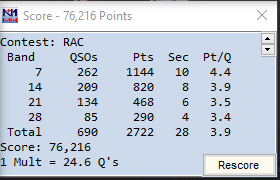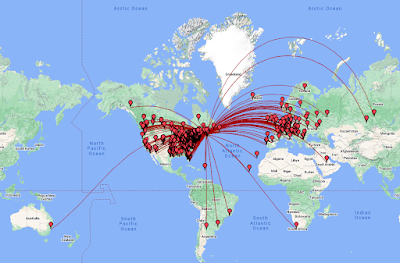 LHS Episode #528: JTDX Deep Dive
LHS Episode #528: JTDX Deep Dive
Hello and welcome to the 528th installment of Linux in the Ham Shack, the first for the year 2024. In this episode, the hosts take a deep dive into the JTDX application for weak signal modes. Topics include features, download and installation (package and build), configuration, operation and much more. Thanks for tuning in and have a great week.
73 de The LHS Crew
Russ Woodman, K5TUX, co-hosts the Linux in the Ham Shack podcast which is available for download in both MP3 and OGG audio format. Contact him at [email protected].
 Reverse Beacon Network strange event
Reverse Beacon Network strange event
During the 2023 Canada Winter contest I had an odd thing happen twice with the Reverse Beacon Network website. But before I go into that let's talk about what I use the Reverse Beacon Network for in contests. This site has a
huge amount of stations that just listen for stations calling CQ. If you
are heard then you are shown on a world map along with your signal
strength to that location. This is a great tool during a contest for me
as it shows where and how strong my signal is. I have used this site for
years but in the last contest, something happened that never has and it
happened twice.
I was calling for some time on 40m CQ contest and I was getting Reverse Beacon Network feedback from my signal. The reporting station MM0ZBH reported me but on 20m? Informing me my signal was 6dB and on 14036 and not 7.030 where I was calling CQ contest this was at 2337UTC.
Earlier at 2212UTC the same station had reported me again on 20m this time at 14030 when I was calling CQ on 7030 and my signal strength this time was 28dB. This was odd and even more so when it happened twice in the contest. Any ideas out there and has anyone had the same issue happen to them?MM0ZBH is the 6th station down on the list
Mike Weir, VE9KK, is a regular contributor to AmateurRadio.com and writes from New Brunswick, Canada. Contact him at [email protected].
 Ham College 108
Ham College 108
Ham College episode 108 is now available for download.
Extra Class Exam Questions – Part 46
E9D Yagi antennas, parabolic reflectors, circular polarization, loading coils, top loading, feed point impedance of electrically short antennas, antenna Q, RF grounding.
George Thomas, W5JDX, is co-host of AmateurLogic.TV, an original amateur radio video program hosted by George Thomas (W5JDX), Tommy Martin (N5ZNO), Peter Berrett (VK3PB), and Emile Diodene (KE5QKR). Contact him at [email protected].
 Amateur Radio Weekly – Issue 314
Amateur Radio Weekly – Issue 314
The ARRL Board is at it again
A newly proposed Code of Conduct, which I believe is the equivalent of a loyalty, confidentiality and obedience pledge to the League itself and not to the members that elect us.
KB6NU
Going on a social media diet
Leaving Twitter, investing in Mastodon.
QRPer
MeshCom 4.0
A project to exchange text messages via LORA radio modules. MeshCom modules can be combined to form a mesh network, but can also be connected to a message network via MeshCom gateways, which are ideally connected via HAMNET.
ICSSW
2023: The Year in Radio
Ham Radio in 2023 was a continual source of rejuvenation and energy.
KC8JC
Introducing QSOMate
A Ham Radio logging application for iPhone, iPad, and macOS Desktop.
MacHamRadio.com
Mini-whips: Junk, right?
The results were very surprising.
Real-World Amateur Radio
Everything you wanted to know about Zulu Time
Zulu Time is the military name for Universal Coordinated Time (UTC).
OnAllBands
AM or SSB are there ‘windows?’
A new voice mode appeared in 1947 when Wes Schum, W9DYV, introduced the first Amateur Radio SSB transmitter.
K9EID via AmateurRadio.com
Somaiya students’ Amateur Radio Satellite takes to the skies
Equipped with a voice repeater and digipeater, the satellite extends its services to the global Amateur Radio community.
HindustanTimes
Video
Demo of 3 Ham study sites
Demo of 3 Amateur Radio study sites in under 3 minutes.
Branvini Films
Salmon Run 2023
WA State QSO Contest from Samish Overlook.
WA7JNJ
Working the ISS Ham Radio Repeater with a Baofeng
My first attempt working the International Space Station Ham Radio Repeater.
W6IWN
The best Ham Radio videos of 2023
Top 10 list.
KB9VBR
Get Amateur Radio Weekly in your inbox.
Sign-up here
Amateur Radio Weekly is curated by Cale Mooth K4HCK. Sign up free to receive ham radio's most relevant news, projects, technology and events by e-mail each week at http://www.hamweekly.com.
 AM or SSB are there ‘windows’?
AM or SSB are there ‘windows’?
Amplitude Modulation has been used for voice transmission between Radio Amateurs for more than a century. A new voice mode appeared in 1947, when Wes Schum, W9DYV introduced the first Amateur Radio SSB transmitter, the Central Electronics 10A. By the late 1950’s and early 1960’s, competition for dial space began to “heat up” between the ‘died in the wool’ AM operators and the new, hard to tune in, Single Sideband operators. Eventually, there was a sit-down, face to face meeting, between some “Big Gun” SSB operators and long time, AM operators. Together, both groups decided on a ‘Gentlemen’s Agreement’, for AM dial space. For example, on 75 meters, they choose 3.870MHz to 3.890MHz as the “AM Window”. On 40 meters, AM around 7.290MHz. 20 meters, 14.268MHz; etc. These “windows’ were promoted by the ARRL and strongly observed by AM operators for a couple of decades.
During the 1980’s and 1990’s AM operations had declined, and many newly licensed SSB operators came to be. Many of them didn’t know AM even existed on the Amateur bands, as the AM Window concept was no longer promoted well, or not acknowledged. However, AM has seen a recent resurgence of popularity, in part due to the introduction of Software Defined Radio Transceivers, such as FlexRadio Systems lineup, the ICOM IC7300, Yaesu FT101DX, Kenwood TS890, Apache Labs Anan 80000DLE, etc. New and old AM enthusiasts have homebrewed Class E modulated solid state AM transmitters. In 2018, QST tested and reviewed the K7DYY AM (only) solid state, Class D transmitter, a near legal limit, AM only transmitter, with built in power supply, that weighs only 8 pounds!
With increased activity, some cross mode interference is sometimes unavoidable. It is always best to remember, NO ONE owns a frequency, regardless of mode. It is good practice to always check the tuned frequency, to make sure it is not already in use, by one, or more stations. Some AM Operators are crystal controlled and cannot easily change frequency. 3.885 MHz for example, is a popular crystal frequency used within the US phone band. With almost all SSB transmitters being frequency agile, would you give the 3885 kHz crystal controlled AM station a little leeway and move a few kHz, if he was there, first?
With the increased number of AM stations, there are now are a few other spots on the dial that AM operation can be found. Both SSB and AM mode users can avoid misunderstanding, or disagreement, if each party observes the AMATEUR’s CODE:
- AMATEUR IS CONSIDERATE
The Amateur is considerate, never knowingly operates in such a way to lessen the pleasure of others. - AMATEUR IS LOYAL
He offers his loyalty and encouragement to fellow amateurs. - AMATEUR IS PROGRESSIVE
Keeps his station efficient and well maintained. His operating practice is above reproach. - AMATEUR IS FRIENDLY
Offers kind assistance, cooperation and consideration for the interest of others. - AMATEUR IS BALANCED
Radio is his hobby. He never allows it to interfere with duties to his home or family. - AMATEUR IS PATRIOTIC
His station is always ready for service of his country.
Adapted from the original Amateur’s Code, written by Paul M. Segal in 1928.
In addition, please ask, “Is the frequency In Use?”
As always, with any mode, asking if the frequency is in use, first, will alleviate an initial misunderstanding. Please remember that the ham bands can change quickly, causing new interference. Acknowledge the changing band, and be friendly about it. I encourage everyone to join AMI: www.aminternational.club. Learn, appreciate, and enjoy AM operation. Lets all be courteous to each other and share our frequencies.
Dr. Bob Heil, K9EID, is the founder of Heil Sound and host of TWiT.tv's Ham Nation which streams live each Tuesday at 6:00pm PT (9:00pm ET) at http://live.twit.tv. Contact him at [email protected].
 All New Technician License Class – Monument, CO
All New Technician License Class – Monument, CO
 The Technician license is your gateway to the worldwide excitement of Amateur Radio, and the very best emergency communications capability available! This is the entry-level class for people who do not currently have an amateur (ham) radio license.
The Technician license is your gateway to the worldwide excitement of Amateur Radio, and the very best emergency communications capability available! This is the entry-level class for people who do not currently have an amateur (ham) radio license.
The Tri-Lakes Monument Radio Association (Monument, CO) is introducing a new approach to teaching the Technician Level ham radio license class. We have completely overhauled the delivery format of our Tech Class to make good use of both in-person and online training methods. The biggest change is that most of the core material will be delivered to the student via bite-sized online videos, ebook sections, and additional content from Ham Radio School. This dramatically increases the flexibility on how and when the student views this material, eliminating long, all-day classroom sessions. We will have three live Zoom sessions along the way to review the material and answer any questions you might have.
We understand that in-person training is extremely valuable for certain types of activities. Accordingly, we will have an in-person kickoff session (Feb 17) for the instructors to meet the students and show them how ham radio equipment is used. The licensing exam session (Mar 9) is another in-person event. Finally, after you receive your new license, we will have an in-person Get On The Air event (Mar 16) where you will make your first radio contact. To help guide you through this process, an experienced radio ham will connect with you, monitor your progress, and help you through the class.
The cost of the class is $50 ($40 for anyone under 18 years old), which includes everything you need for the class. A non-expiring subscription to the Ham Radio School Technician resources is included. We used to require you to have a printed copy of the Ham Radio School Technician book, but that same material will be delivered to you online as an ebook. Proceeds from this class go to support the Tri-Lakes Monument Radio Association, a non-profit organization.
You still need to pay a $35 license fee directly to the FCC after passing the license exam.
More details are in the attached flyer.
To register, go here:
https://w0tlm.com/radio-classes/tech-registration
You can probably tell I am excited about the new format for this class. It will make it easier on the instructors to deliver the material AND easier for the students to learn it. If you have questions, let me know!
Bob K0NR
[email protected]
The post All New Technician License Class – Monument, CO appeared first on The KØNR Radio Site.
Bob Witte, KØNR, is a regular contributor to AmateurRadio.com and writes from Colorado, USA. Contact him at [email protected].
 Canada Winter contest results
Canada Winter contest results
I am a bit behind with my posting about the Canada Winter contest that happened last weekend. I have been occupied with looking back on 2023 and my New Year's post. As said last weekend was the Canada Winter Contest I took part in the CW-only category and had a blast. The contest covers from 2m to 160m (excluding WARC bands) SSB and CW in which you can do either of both. The conditions were great in this part of the world and the bands were busy with contesters. I called CQ contest (running) for over 90% of the contest which helped me greatly to improve on working pileups.
Some of the contact highlights were contact into the Yukon, South Africa and Australia. My average QSO's per hour was 66 and my highest was 90 per hour. The antenna I was using was the Hustler 4BTV (10m-40m) this limited me from 80 and 160 therefore on Friday evening I had to pull the plug at about 0120 UTC as 40m was closing down for me. The contest finished at 2359UTC on Saturday but I was getting tired and pulled the plug at 2330UTC.
During the day on Friday here in New Brunswick, we did have some freezing rain and that affected some radio ops down this way. Fortunately, I can tilt my antenna over which I did and cleaned the ice off and put it upright again. I did this just before the start of the contest and had no issues.
I loaded my log in ADIF format into Log Analyzer which gave me a map representation of my contacts. You can see my two distant contacts in South Africa and Australia. This software uses the station's grid square for map location. The issue with this is incorrect grid squares give you some odd results. In my case, the map shows one station in Saudi Arabia and another in the middle of the ocean. Both are a result of an incorrect grid square. But overall the program works great and gives you a nice visual of your contest contacts. The Log Analyzer software does have a workaround for when this happens details are found in a link in red at the top of the website page.
 |
| Almost worked all provinces. |
Mike Weir, VE9KK, is a regular contributor to AmateurRadio.com and writes from New Brunswick, Canada. Contact him at [email protected].



















